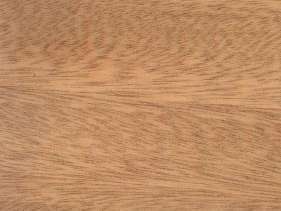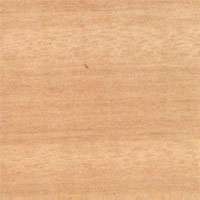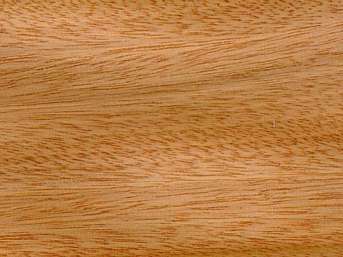  
Africian canarium (Canarium schweinfurthii)
Family: Burseraceae
Common names: Abe, Abel, Abeul, African canarium, Africian canarium, Ahie, Aiele, Amonkyi, Bediwenua, Beri, Bidikala, Billi, Bobele, Buhura, Canarium, Elemi, Eyere, Gbebi, Incense tree, Kandangunuu, Kantankrui, Kurutwe, M'bili, Mbele, Mbidikala, Mbidinkala, Mbili, Mubafu, Mubani, Mubili, Mupafu, Mwafu, Omusanki, Omuwafu, Ovili, Owele, Owele ovili, Papo, Safukala
Distributed in: Angola, Benin, Cameroon, Central African Republic, Congo, Equatorial Guinea, Gabon, Ghana, Ivory Coast, Liberia, Nigeria, Sierra Leone, Sudan, Tanzania, Uganda, Zaire (Africa)
Distribution overview: Widely distributed in East, Central, and West Africa.
Common uses: Agricultural implements, Bent Parts, Boat building (general), Boxes and crates, Cabinetmaking, Casks, Chairs, Chemical derivatives, Chests, Decorative plywood, Decorative veneer, Desks, Dining-room furniture, Domestic flooring, Door, Drawer sides, Excelsior, Figured veneer, Fine furniture, Flooring, Fuelwood, Furniture , Furniture components, Furniture squares or stock, Furniture, Hatracks, Heavy construction, Joinery (external): ground contact, Joinery, Kitchen cabinets, Light construction, Living-room suites, Millwork, Moldings, Office furniture, Packing cases, Paneling, Parquet flooring, Particleboard, Plywood corestock, Plywood, Poles, Posts, Pulp/Paper products, Radio - stereo - TV cabinets, Rustic furniture, Stools, Structural plywood, Turnery, Utility furniture, Utility plywood, Veneer, Veneer: decorative, Wardrobes
Product sources: The ITTO reports that timber from this species is produced only occasionally and is exported in low but regular volumes.
Environment profile: Vulnerable in parts of its natural habitat
Tree size: Trunk diameter is 100-150 cm
Colors: the heart isYellow to golden-yellow to orange, Yellowish tanand the sapwoodWhite to yellow, Yellowish-brown.The grain isWavy, the textureMedium coarse to coarseand the lusterPronounced
Natural durability: Susceptible to marine borer attack, Susceptible to termite attack
Odor: No characteristic taste
Silica Content: Siliceous
LightInduced Color Change: Darker
Kiln Schedules: UK=H US=T10D4S/T8D3S Fr=7
Kiln Drying Rate: Very slow (>28 days for boards < 32 mm, to >84 days for boards >= 63 mm)
Drying Defects: Slight surface checking, Slight twist/warp
Ease of Drying: Thick Stock Requires Care
Tree Identification: Bole/stem form is straight
Comments: Canarium contains a whitish gum which is reported to solidify to the consistency of wax and burns freely when lit. Uses of African canarium are rather limited because it dulls cutters rapidly and severelyGeneral finishing qualities are rated as good
Blunting Effect: High to severe
Boring: Fairly easy to very easy
Use three winged drills for the best results
Carving: Fairly Easy to Very Easy
Cutting Resistance: Material with interlocked grain can be difficult.
Gluing: Satisfactory gluing properties
Mortising: Fairly Easy to Very Easy
Moulding: Good finishing
Movement in Service: Good finishing
Nailing: Holds nails well, Satisfactory nailing properties
Planing: Satisfactory planing properties
Resistance to Impregnation: Sapwood is treatable
Response to hand tools: Moderate working qualities
Routing recessing: Fairly Easy to Very Easy
Sanding: Good sanding qualities
Veneering qualities: There is slight to moderate drying degrade and the potential for buckles and splits, Various figures can yield decorative veneers
Steam bending: Very poor
Screwing: Fair screwing qualities (expect < 70% of screwed pieces to be free from complete splits), Screwing yields good results; Turning: Special attention required
Painting: Satisfactory; Polishing: Satisfactory; Staining: Very Good to Excellent; Varnishing: Satisfactory;
- Numerical data Metric
- Numerical data English
- Strength properties
- References
 |
 |
 |
 |
| Item |
Green |
Dry |
Metric |
| Specific Gravity |
0,36 |
|
|
| Density |
|
496 |
kg/m3 |
| Bending Strength |
408 |
667 |
kg/cm2 |
| Crushing Strength |
230 |
415 |
kg/cm2 |
| Hardness |
|
235 |
kg |
| Impact Strength |
43 |
40 |
cm |
| Shearing Strength |
|
103 |
kg/cm2 |
| Stiffness |
74 |
91 |
1000 kg/cm2 |
| Tangential Shrinkage |
6 |
|
% |
| Radial Shrinkage |
3 |
|
% |
| Weight |
528 |
496 |
kg/m3 |
| Maximum Load |
0,35 |
0,42 |
cm-kg/cm3 |
| Toughness |
|
|
cm-kg |
| Static Bending |
|
|
kg/cm2 |
|
 |  |  |  | | Item | Green | Dry | English | | Bending Strength | 5813 | 9497 | psi | | Density | | 31 | lbs/ft3 | | Hardness | | 520 | lbs | | Impact Strength | 17 | 16 | inches | | Maximum Crushing Strength | 3274 | 5904 | psi | | Shearing Strength | | 1479 | psi | | Stiffness | 1058 | 1305 | 1000 psi | | Work to Maximum Load | 5 | 6 | inch-lbs/in3 | | Specific Gravity | 0.36 | | | | Weight | 33 | 31 | lbs/ft3 | | Radial Shrinkage | 3 | | % | | Tangential Shrinkage | 6 | | % | | Volumetric Shrinkage | 14 | | % | |
Bending strength (MOR) = low 0
Hardness (side grain) = very soft 0
Density (dry weight) = 31-37 lbs/cu. ft. 0
Max. crushing strength = medium 0
Modulus of Elasticity (stiffness) = very low 1
Modulus of Elasticity (stiffness) = low
Shrinkage, Radial = small
Shearing strength (parallel to grain) = low
Max. crushing strength = low
Density (dry weight) = 38-45 lbs/cu. ft.
Shrinkage, Volumetric = large
Shrinkage, Tangential = moderate
Bending strength (MOR) = very low
Bending strength (MOR) = medium
Toughness-Hammer drop (Impact Strength) = very low
Shrinkage, Volumetric = fairly large
Density (dry weight) = 23-30 lbs/cu. ft.
Surfaces may dent or scratch easily
Surfaces may dent easily
Soft
Shrinkage, Tangential = very small
Shearing strength (parallel to grain) = very low
Hardness (side grain) = soft
Density (dry weight) = 15-22 lbs/cu. ft.
Compression strength (parallel to grain) = medium
Bending strength of the species is considered medium, being much weaker than White oak or Teak in the air-dry condition (about 12 percent moisture content). Compression strength parallel to grain, or maximum crushing strength, is medium. It is lower in this property than Teak. Surfaces may dent or scratch easily since the wood is soft. The weight is about average. The density is average, or medium.
Armstrong, F.H.,1960,The Strength Properties of Timber,Forest Products Research Laboratory, London Bulletin,No.45Bertin, A., Meniaud, J.,1949,Timbers of the Cameroons,Compagnie Francais du Cameroon,(Transl. by F.Jane)Bois et Forets des Tropiques,1979,Aiele,Bois et Forets des Tropiques,187,pp65-78Bolza, E., Keating, W.G.,1972,African Timbers - the Properties, Uses and Characteristics of 700 Species,C.S.I.R.O. Div. of Building ResearchBrown, W.H.,1969,Properties and uses of Tropical hardwoods in the United Kingdom. Part 1,Nonstructural properties and uses.,Conference on Tropical hardwoods SC-5/TN-5, Syracuse UniversityChudnoff, M.,1984,Tropical Timbers of the World,U.S.A. Department of Agriculture, Forest Service, Forest Products,Laboratory, Madison.Clifford, N.,1953,Commercial Hardwoods - Their Characteristics Identification and,Utilization,Sir Isaac Pitman & Sons Ltd. LondonCooper, G.P., Record, S.J.,1931,The Evergreen Forests of Liberia,Yale School Forestry Bulletin,31,pp1-153Erfurth, T., Rusche, H.,1976,The Marketing of Tropical Wood A. Wood Species from African Moist Forests,F.A.O. Forestry DepartmentFarmer, R.H.,1972,Handbook of Hardwoods,HMSOForest Products Research Laboratory, U.K.,1955,Kiln-Drying Schedules,Forest Products Research Laboratory, Princes Risborough, Department of,Science and Industrial Research, Building Research Establishment Leaflet,No.42Forests Products Research Laboratory, U.K.,1956,A Handbook of Hardwoods,Forest Products Research Laboratory, Princes Risborough, Department of,Science and Industrial Research, Building Research EstablishmentFortin, Y., Poliquin, J.,1976,Natural Durability and Preservation of 100 Tropical African Woods,International Development Research Centre, CanadaFouarge, J., Gerard, G.,1964,Bois du Mayumbe,I.N.E.A.C. BelguimFouarge, J.,1950,Appropriation de Bois Congolais aux Besoins de la Metropole,I.N.E.A.C. Belgium Serie Technique,No.38Fouarge, J.,1953,Bois du Congo,I.N.E.A.C.Fouarge, J.,1970,Essais Physiques,Mecaniques et de Durabilite de Bois de la Republique,Democratique du Congo,I.N.E.A.C. Belgium Serie Technique,No.76France - C.T.F.T./C.T.B.,1982,Guide pour le Choix des Essences Deroulables-pour la fabrication du,contreplaque,C.T.F.T./C.T.B. FranceFrance - C.T.F.T.,1966,Bois Tropicaux,C.T.F.T. Publ.,12France - C.T.F.T.,1977,Promotion of African Timbers - New Species,CTFT,35 LeafletsGhana - Timber Marketing Board,1969,Ghana Hardwoods,Timber Marketing BoardHMSO. 1972. Handbook of Hardwoods. 2nd Edition. Revised by R.H. Farmer. Department of the Environment, Building Research Establishment, Princes Risborough Laboratory, Princes Risborough, Aylesbury, Buckinghamshire.Hughes, J.F.,1971,The Principal Timber Trees of Cameroon,Unpublished dataI.U.F.R.O.,1973,Veneer Species of the World,Assembled at F.P.L. Madison on behalf of I.U.F.R.O. Working Party on,Slicing and Veneer CuttingIrvine, F.R.,1961,Woody Plants of Ghana,O.U.P. LondonITTO.1986.Tropical Timber Atlas, Volume 1 - Africa.International Tropical Timber Organization (ITTO) and Centre Technique Forestier Tropical (CTFT, 45bis, Avenue de la Belle Gabrielle, Nogent-sur-Marne Cedex, France.Jay, B.A.,1968,Timbers of West Africa,TRADA, Red Booklet SeriesKeay, R.W.J.1989. Trees of Nigeria.Revised Version of Nigerian Trees. Clarendon Press, Oxford.Kinloch, D., Miller, W.A.,1949,Gold Coast Timbers,Govt. Printer Gold CoastKoeppen, A. von,1958,Pulping Studies on Eucalyptus degupta, Bruguiera parviflora, Avicennia,marina,Tappi,41(8,PP460-4Kryn, J.M., Forbes, E.W.,1959,The Woods of Liberia,U.S.A. Department of Agriculture,Forest Products Laboratory, Madison,,Report No. 2159Kukachka, B.F.,1970,Properties of Imported Tropical Woods,Forest Research Paper FPL 125Lavers, G. M.1966.The Strength Properties of Timbers.Forest Products Research Bulletin, No. 50.Ministry of Technology, Her Majesty's Stationery Office, London.Lavers, G.M.,1983,The Strength Properties of Timber (3rd ed. revised Moore G.L.,Forest Products Research Laboratory, Princes Risborough, Building Research,Establishment Report (formerly Bulletin No.50)Lebacq, L., Dechamps, R.,1967,Contribution a un Inventaire de Forets du Nord-kasai,Musee Royal de L'Afrique Centrale Belgium Annals Series 8 No.5Pardy, A.A.,1952,Notes on Indigenous Trees and Shrubs of S. Rhodesia - Albizzia antunesiana,Ministry of Agriculture and Lands S. Rhodesia Bulletin,No.1603Patterson, D.,1988,Commercial Timbers of the World, 5th Edition,Gower Technical PressPieters, A.,1977,Essences Forestieres du Zaire,R.U.G. Gent BelguimRevue des Bois et de ses Applications,1955,Aiele (Canarium schweinfurthii,Revue des Bois et de ses Applications,10 (2, p33Sallenave, P.,1955,Proprietes Phyiques et Mecaniques des Bois Tropicaux de l'Union Francaise,C.T.F.TSallenave, P.,1964,Proprietes Physiques et Mecaniques des Bois Tropicaux (Premier Supplement,C.T.F.T. Publ.,no.23Tack, C.H.,1969,Uganda Timbers,Govt. Printer UgandaTanzania Forest Department,1961,Timbers of Tanganyika - Brachystegia spiciformis,Tanzania Forest Dept. Util. Sec. Moshi - Timbers of TanganyikaTimber Information Assoc. Ltd.,1947,Notes on East African Timbers,TRADA, Timber Information, No.28Uganda Forest Department,1954,Canarium,Uganda Forestry Department Timber Leaflet,No.12Uganda Forest Department,1969,The Shrinkage of Some Ugandan Timbers,Uganda Forestry Department Timber Leaflet,No.47WCMC. 1992. Conservation Status Listing - Trees and Timbers of the World. World Conservation Monitoring Center-Plants Programme, Cambridge, CB3 ODL, United Kingdom.
|










